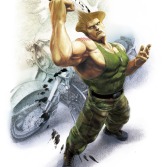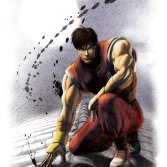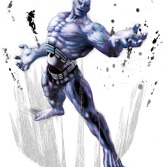Alternative Title: Why Realistic Body Images Matter in Video Games.
Introduction
At the time of writing I’ve received my university dissertation back. My topic in the broadest sense,was female representation within anime fuelled by my interest in feminist film studies. Similar to my Marxism and postmodernism work I’ve been wanting to tackle video games and feminism in one article.
Feminism and video games have never seen eye-to-eye. Whether it be a reactionary look at “trashy male fantasies”, a perfectly valid critical (the verb not the adjective) view of tropes within video games or calling for bans due to perceived violence against female characters, feminism is considered by some, ahem, “delightful” individuals as being a scourge on the industry. Just for kicks I decided to go back to my university textbooks and found a plethora of ideas I wanted to run through video games with, including some from feminist’s sister theory, masculinity.
Edit: My research questions for this piece were;
- How are both male and female characters designed and are they designed in a way that is meant to flaunt their sexiness?
- Does the context of the character tie in with how they have been designed, i.e. if they are presented sexually, does it make sense within their role in society?
- How do the designers aid or encourage this within the text?
[Return back to original text]
One of the main themes at play in both feminist and masculine theories is appearance, so I needed a game genre where characters appearance was one of the defining qualities. I decided on fighting games as my topic for many reasons.
- The gameplay is all about character. How they move, talk, and fight speaks volumes about them.
- While many have a story mode it’s not the main reason why people play therefore even more attention can be paid to point No.1. [Edit: Context is important however, so a character’s backstory will be taken into consideration].
- I love fighting games therefore I can’t be called biased for going after I game or genre I don’t like. I’ll even be going after my favourite characters, just to show my dedication. This video is not going to be me (start at 1:48-1:54).
This essay is also going to be quite long as I’m going to be using two games as a comparison. The main bulk will be about Street Fighter (I’m using Super Street Fighter IV because it’s the version I’ve got and can’t find Ultra, deal with it) and the comparison is Virtua Fighter 5. But anyway, let’s start.
Edit: I will be using the Western names for the Street Fighter characters, e.g. Vega is Claw, Bison is Dictator, and Balrog is Boxer.
Part I: Design
Speaking for myself I believe that fighting games along with MOBAs (Multiplayer Online Battle Arena’s) such as League Of Legends have some of the best and iconic characters ever devised. I think this is due to the lack of narrative fluff. There are overarching storylines in fighting games and MOBAs but most players are there for the gameplay. As I said before characters have to display all their…well, character through their movement and sporadic use of quotes. For example, Ryu, the de-facto main character of SF (Street Fighter), is a honourable character. I can tell this through his quotes and his fighting style. Here is a selection of his quotes;
“Each time I fight, I learn something new.”, “The power I am after is the power to win – not the power to destroy.”, “If you go into the ring expecting to fail, you will. Believe in yourself!”
In conjunction to this his fighting style is usually seen as a beginner level with simple inputs that teach the player things such as fireball and uppercut and no sly moves like throwing dirt at the opponent, which a character like Cody (a jailbird) does. These fireball/uppercut attacks are shared with other characters such as Sagat, Sakura, and Ken, allowing the player to gravitate towards a character they like once they have learnt the fundamentals.
So, with that introduction out of the way let’s talk design.
The main complaint against video game characters especially female game characters is the gross over-sexualisation of the female characters and the lack of any other body type than traditionally “sexy”, i.e. slim body, long legs, large breasts. Compared to the men of Street Fighter this is obvious. While there is a case that the multitude of ripped torsos in SSFIV (Super Street Fighter IV) is sexualisation on the part of the male characters that is not all there is.
The male characters in SSFIV come in all shapes and sizes, from grossly overweight (Rufus), to almost skeletal (Dhalsim) and includes characters that you can’t see the muscles of (M. Bison and Gen). Their age can also be a factor with Gen and Gouken being old men. Through the character profiles the main aspect seems to be strength, with Ryu, Ken, Zangief and others focussing on their muscles than active scopophilia (the term Freud invented for taking pleasure in looking). Others, like Cody and Hakan show characters traits and Adon, Fei Long and Sagat are performing moves. Click on the pictures to see the character artwork. (Note: I have tried to keep to the same art style, but for certain character like Makoto, I was unable to find one from the same style. Photos retrieved from Street Fighter Wikia, Video Game Artwork.com, and Pinterest.com).
Nearly all the women on the other hand are young and wearing little or very form fitting clothing to accentuate their proportions with most showing bare skin. These can be seen in Sakura’s bare legs and midriff, Juri’s bare midriff and Cammy, Rose, and Chun Li’s legs. Cammy and Ibuki are positioned with their buttocks towards the camera while C.Viper is in a pose where her oversized breasts are in the centre of the shot. Apart from Makoto and Sakura, they all wear skin-tight or form-fitting clothes.
“Jiggle Physics” (the animation that makes breasts move “realistically”) also plays a part in this discussion by the fact that “Jiggle Physics” is an actual phrase and isn’t swept up with the rest of the animation.
Shohini Chaudhuri, a feminist film scholar, wrote that in film, “The camera fetishistically isolates fragments of [female] bodies (face, breasts, legs)…” (2006, p.35). Looking through the female character profiles you can see that the character illustrations accentuate those fragments Chaudhuri identifies. The face is also highlighted by design director Toshiyuki Kamei. When asked which part of design gets the most attention he replied, “[with] female characters…I would have to say the face.” (Jigsaw, 2009). Out of all the female illustrations only Makoto looks like she is ready for a fight, wearing a gi and striking a fighting stance.
The sexualisation of the female characters takes on another facet when it turns out certain characters were designed that way. According to design director for SSFIV Toshiyuki Kamei, Juri was ordered to have “…more sideboob…” (Jigsaw, 2009) and her Feng Shui Engine (a device that enhances a fighters potential) was removed from her stomach because, “…putting a big globe in the stomach of a female character wasn’t going to look very attractive.” (Jigsaw, 2009). Her outfit also has a spider motif which is symbolic of the sexually aggressive female being associated with spiders due to their habit of eating mates.
Another character that was designed sexually was Chun Li. According to Yoko Shinomura, Chun-Li has big thighs due to designer Akira Yasuda’s attraction. The quote in the full context;
“Chun-Li has big thighs, right? So back in the day, I asked Mr. Yasuda, “Why does she have such big thighs?” And he started shouting and went off and was like, “I can’t believe you don’t understand the appeal.” And he started explaining the attraction…explaining his fetishes…” (Leone, 2014, Ch. 2, Art Show).
Even just looking at the design aspect of the character and disregard context and speech (which we will get onto shortly) it is clear that women in the Street Fighter universe are sexualised to a degree. However, their over-stylised look may be another design trick. Street Fighter producer Yoshinori Ono said the exaggeration of characters has a purpose. He said,
“…hands, feet and fireballs in the series have always been larger than they need to be, because they serve as visual markers on the screen…these appendages became more pronounced once the series transferred over to 3D models.” (Grey, 2016).
It could also be stated that the fact there are characters throwing fireballs in the first place allows for a lack of verisimilitude with design due to the outlandish actions of characters. The fact the games are made in Japan could also lend some clarity to the topic. According to Susan Napier, Japanese animation, “…brings the body to the fore, not only in terms of sexuality but also in relation to aesthetics, gender and social identity.” (2005, p.64). This realisation also makes sense in terms of male bodies as well as I highlighted they mostly focus on strength which falls under aesthetics.
The final aspect in terms of design is the health bar of the characters. Each character can withstand different types of punishment. This is a standard of game design and gives us variation instead of each character feeling the same. Looking at the defensive graph the majority of SF men have higher life bars with all women falling in the Below Average and Poor ratings (EventHubs, n.d.). This may be a balancing act (stronger characters being slower, weaker being faster) but research provided by EventHubs proves that women in SSFIV range from one of the fastest to the slowest with one in every grouping (Walk speed…, 2010).
Part I-B: Virtua Fighter 5
I intentionally chose Virtua Fighter 5 for this essay for a few reasons, but the main crux is its design choices. While Street Fighter, along with other popular fighting games like Tekken and Mortal Kombat have their fair share of ridiculousness be it ninjas who can shoot ice, boxing kangaroos, or the literal devil, Virtua Fighter is off to the side with its focus squarely on realism. This was at the forefront of the designers minds when they created it. To get the look for the martial arts right, Yu Suzuki, director/producer of the first game, “…had all of his designers study the ‘kata’ [a string of moves] of various martial arts, the best of which are incorporated into the game.” (Modelah, 2014).
There are no fireballs or impossible gravity-defying moves, it’s as close to a proper multi-martial arts tournament as you’ll get in a video game outside of the official UFC games. I’ll get onto character models later, but the only thing that is remotely out of place is a robot called Dural who is the “boss” at the end of the game. She has all the other characters best moves, but I’m discounting her from the discussion due to her being a secret character and not part of the character selection screen until the game is fully beaten. So then, onto design.
Sidenote: The characters in VF similar to a lot of fighting characters have several different costume variants. As this post is going to be longer than most I’m going to simply use their default costumes, these are the ones that are featured in profiles and the ones the majority of players would see.
The male characters of VF profiles are surprisingly quite a bit different from SF. Only one (Jeffry) is possibly showing off his muscles. Others like El Blaze and Wolf are shirtless, but they are standing rather normally and aren’t flexing for the camera like Zangief, Balrog, or Hakan in SF. Many of the males are fully clothed as well so they can’t even show off their ripped bodies even if they had them. The only one who might be a counter to this is Brad (my main in VF, I told you I’d be going after my boys), whose arms on his hips and open shirt are directing the gaze to his abs and chest. However, this profile will be explained in the next chapter as this is a perfect example of design working with a character’s personality. Click on the pictures to see for yourself. (Photos retrieved from fightersgeneration.com, Virtua Fighter Wikia, and Pinterest.com).
Women in Virtua Fighter 5 follow the same design philosophy. The most obtuse female character is Vanessa whose default outfit is an open shirt revealing her black bra underneath. A secondary could possibly be Sarah, whose skin-tight jumpsuit and cocked hip indicate a playfulness about her. The rest; Pai, Eileen and Aoi are dressed rather modestly, striking poses that indicate them as either fighters or as part of their personality such as Eileen performing an acrobatic jump and Aoi performing a traditional dance move. Vanessa, despite her partly sexualised look is still adopting a fighting stance, so that feeds back that she is a fighter, something which may not have been clear for fighters in the SF profiles.
Japanese culture scholar Dolores Martinez highlighted that in most Japanese pop culture, “…women are held to be gentle, submissive and beautiful…” (1998, p.2). While this doesn’t suit most of the women in VF5 it is true of the character of Aoi. Aoi uses Aiki-jujutsu and is suited to defensive play due to having the highest number of reversals/counters of anyone in the game. While she can punch, kick, and grapple, the fact that her unique attacks are defensive oriented means she is much more gentle than aggressive. In her win quotes she speaks at a relatively quiet tone and in VF narrative. And finally Aoi doesn’t like Brad because he flirts with her, showing that she is attractive to somebody.
End of Part I
Link to Part II.
Link to Bibliography.
Banner photo source: digitalspy.com.





















































4 thoughts on “A Feminist/Masculine Critique of Fighting Video Games: Part I”